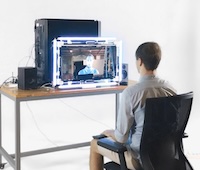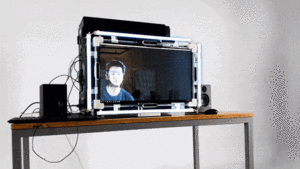|
Telewindow began in pre-covid 2018 as a lean, open-ended, unfettered exploration into what can be done with glasses-free multi-view stereoscopic-3D teleconferencing, and was pre- (or a-) entrepreneurial by design.
We worked with several dozen fearless arts and CS grads from several NYU Global campuses over several summers. Our goal was exploration over exploitation, with attention toward both social impact and commercial potential without jeopardizing academic or artistic integrity along the way.
We see Telewindow as an exemplar project for bridge-building between the R and D communities, as well as offering a potential funding means for making more stuff early.
Early Teaser Video (2018):
Telewindow Progress Report, NYU Shanghai, September 2018, YouTube (2:00).
Academic Paper (2021):
"TeleWindow: A Flexible System for Exploring 3D Immersive Telepresence Using Commodity Depth Cameras" with Cameron Ballard & David Santiano, Proceedings for the International Symposium on Electronic Art (ISEA), Barcelona, SPAIN Jun 2022.
Popular Paper about a post-covid hack (2021) (>36k views [2024]):
"A Cheap Simple Hack for Improving Your Online Classtime Experiences," Medium, Jan 2021.
US Patent (2024):
“Systems and Methods for Interpolative Three-Dimensional Imaging within the Viewing Zone of a Display,” USPTO 12,069,408, NYU Shanghai, Aug 2024.
Related Publications & Presentations
"Being Early: Challenges and Opportunities as VR Grows Up," Presence, 25th Anniversary Issue, MIT Press, 25.2, November 2016.
"I used to think patents were cool" opening remarks for Patent Pending exhibition. ZERO1: The Art & Technology Network, San Jose, Oct 2013. YouTube (36:14).
"Open
Patent Protection" short, dated (2010) essay yet still ranks #1 on such Google searches.
Credits
Principal Research Associates include Cameron Ballard, Runxin Bruce Luo, David Santiano, and Ada Zhao. Students and recent graduates who have worked with us include Barak Chamo, Danxiaomeng Ivy Huang, Deyin Mia Zhang, Diana Yaming Xu, Grace Huang, Jingtian Zong, Mateo Juvera Molina, Nathalia Lin, Tianyu Michael Zhang, Xincheng Huang, Xinran Azena Fan, Yufeng Mars Zhao, Yunru Casey Pan, Zhanghao Chen, and designers Ignazio Moresco and Paolo Salvagione. We gratefully acknowledge NYU support from Clay Shirky, Xiaojing Zu, and Jeffrey Lehman for this project.
|

